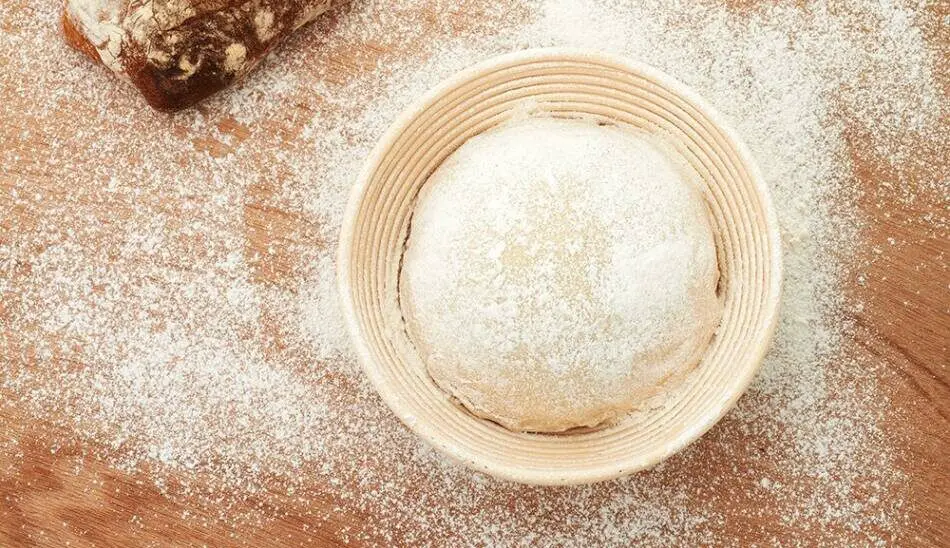Transferring Sourdough from the Banneton to a Hot Dutch Oven using Parchment Paper
The safest way to transfer your sourdough from the banneton to the hot preheated dutch oven is by first flipping the loaded banneton onto a parchment paper, then by gripping the sides of the parchment paper, the dough is lifted up and gently lowered into the hot dutch oven.
This method allows the baker to lower the dough into the hot dutch oven in a slow and controlled manner, reducing the risk of burning your fingers as it makes contact with the hot dutch oven walls.
As the dough is loaded slowly into the dutch oven, we can make sure the dough is loaded onto the center of the dutch oven. If one side of the dough is too close to the wall of the dutch oven, the shape of the baked loaf will be distorted as the walls of the dutch oven constricts the expansion of the dough during oven spring.
Detailed step-by-step guide using parchment paper:
- Cut out a piece of parchment paper which should be 3-5 inches longer on all sides when compared to the widest opening of the banneton.
The parchment paper should be wide enough that your fingers have some space to grip the parchment paper on its side once the dough has been transferred onto it, the extra space is required to lift up the dough and lower it into the hot dutch oven. At the same time it shouldn’t be too wide that the parchment paper protrudes out of the dutch oven when loaded.
Remember that higher hydration dough tends to be weak and will flatten out more as it leaves the banneton and after it is scored, so make sure the parchment paper is big enough that the dough does not flow out of the parchment paper.
- Take the cut out piece of parchment paper and place it on top of the banneton.
- Take a dinner plate and rest it face down on top of the parchment paper and banneton.
- Then, flip the dinner plate and banneton upside down, at the same time using your hands to apply pressure to ensure that the dinner plate and banneton remains in contact throughout the flip.
- The dinner plate should now be at the bottom while the banneton is at the top. Gently remove the banneton to be careful not to tug and pull at the carefully shaped dough. If the dough sticks to the banneton and you are not gentle as you remove it, the skin of the dough will tear and the dough will flatten out.
- Now the dough should be resting on the parchment paper. This is usually the time when we score the dough. After scoring, grip the sides of the parchment paper and gently lift it up and lower it into the hot dutch oven.
Transferring Sourdough from Banneton to Hot Dutch Oven without Parchment Paper
If you have run out of parchment paper, we can still safely transfer the sourdough from the banneton to a hot dutch oven. However, this method can only be done safely using a flat lid dutch oven, or a combo cooker dutch oven.
A flat lid dutch oven or a combo cooker dutch oven can be used either side up since both parts of the dutch oven is flat. To transfer the dough from the banneton without parchment paper, we need to load the dough onto the lid of the dutch oven, as the height of the walls of the lid is much shorter than the pot of the dutch oven.
Take the loaded banneton on one hand and flip it swiftly onto the lid of the hot dutch oven. We can flip the banneton directly onto the lid of the hot dutch oven without using parchment paper because the walls of the lid is short and the chances of burning your fingers is relatively small.
Detailed step-by-step guide without parchment paper:
- Place the lid of the preheated dutch oven on your work surface and bring the loaded banneton as close as possible to the lid to reduce the distance at which the banneton will have to travel mid air as it makes the flip.
- Then lift up the banneton using one hand craddling the bottom and swiftly flip it onto the lid of the dutch oven. It is important to only use one hand as you make the flip to ensure full control of the banneton; it is harder to coordinate the movement of two hands to make a swift and clean flip.
- Gently remove the banneton to prevent the surface of the dough from tearing.
- Score the dough, and close the dutch oven by placing the pot side of the dutch oven onto its lid.
How to prevent dough from sticking to banneton?
The best way to prevent your dough from sticking to the banneton is to line the banneton with a piece of tight woven cloth, and dusting generously with flour. We should also lightly dust the surface of the dough with flour and spread it out evenly using our hands before the dough is loaded into the banneton.
Why does my dough flatten out once it leaves the banneton?
The dough that flattens and does not hold its shape after it leaves the banneton can be caused by a number of reasons, including but not limited to excessive hydration, insufficient gluten development and insufficient skin tension during shaping.
I have written a detailed article explaining the 10 reasons why your sourdough feels loose and too weak to hold its shape, including the 3 reasons listed above. Read Why Sourdough Feels Loose and Does Not Hold its Shape?
Transferring Sourdough from Banneton to a Baking Stone using Parchment Paper
The key tool that we need to transfer a dough from the banneton to a hot baking stone in the oven is an oven peel. The dough is transferred out of the banneton onto a parchment paper, which is then placed on top of the oven peel. Using the oven peel, the dough is lifted into the oven and slid onto the baking stone.
Detailed step-by-step guide using parchment paper:
- Cut out a piece of parchment paper which should be 3-5 inches longer on all sides when compared to the widest opening of the banneton.
The parchment paper should be wide enough that your fingers have some space to grip the parchment paper on its side once the dough has been transferred onto it, the extra space is required to lift up the dough and lower it into the hot dutch oven.
Remember that higher hydration dough tends to be weak and will flatten out more as it leaves the banneton and after it is scored, so make sure the parchment paper is big enough that the dough does not flow out of the parchment paper.
- Take the cut out piece of parchment paper and place it on top of the banneton.
- Take a dinner plate and rest it face down on top of the parchment paper and banneton.
- Then, flip the dinner plate and banneton upside down, at the same time using your hands to apply pressure to ensure that the dinner plate and banneton remains in contact throughout the flip.
- The dinner plate should now be at the bottom while the banneton is at the top. Gently remove the banneton to be careful not to tug and pull at the carefully shaped dough. If the dough sticks to the banneton and you are not gentle as you remove it, the skin of the dough will tear and the dough will flatten out.
- Now the dough should be resting on the parchment paper. Lift the dough up and rest it on the oven peel by gripping the sides of the parchment paper.
- The dough should now be resting on the parchment paper, on top of the oven peel. Using the oven peel, lift the dough into the oven, and gently angle the oven peel in such a way that the dough slides onto the centre of the baking stone. Since the dough rests on the parchment paper, it will easily slide down from the oven peel onto the baking stone.
Transferring Sourdough from Banneton to a Baking Stone without Parchment Paper
If you have ran out of parchment paper, the dough can be transferred directly from the banneton onto a well dusted oven peel. The coating of dusting flour on the oven peel creates a non-stick surface which allows the dough to slide out of the oven peel easily without sticking.
Detailed step-by-step guide without parchment paper:
- Generously dust the oven peel to create a non-stick surface which the dough will rest on.
- Bring the loaded banneton as close as possible to the oven peel to reduce the distance at which the banneton will have to travel mid air as it makes the flip.
- Then lift up the banneton using one hand craddling the bottom and swiftly flip it onto the center of the oven peel. It is important to only use one hand as you make the flip to ensure full control of the banneton; it is harder to coordinate the movement of two hands to make a swift and clean flip.
- Gently remove the banneton to prevent the surface of the dough from tearing.
- Score the dough.
- Lift the dough up using the oven peel to bring it into the oven. Angle the oven peel to help the dough slide off it, and gently pull the oven peel back to drop the dough onto the centre of the baking stone.


